2005 SUBARU BAJA weight
[x] Cancel search: weightPage 8 of 469
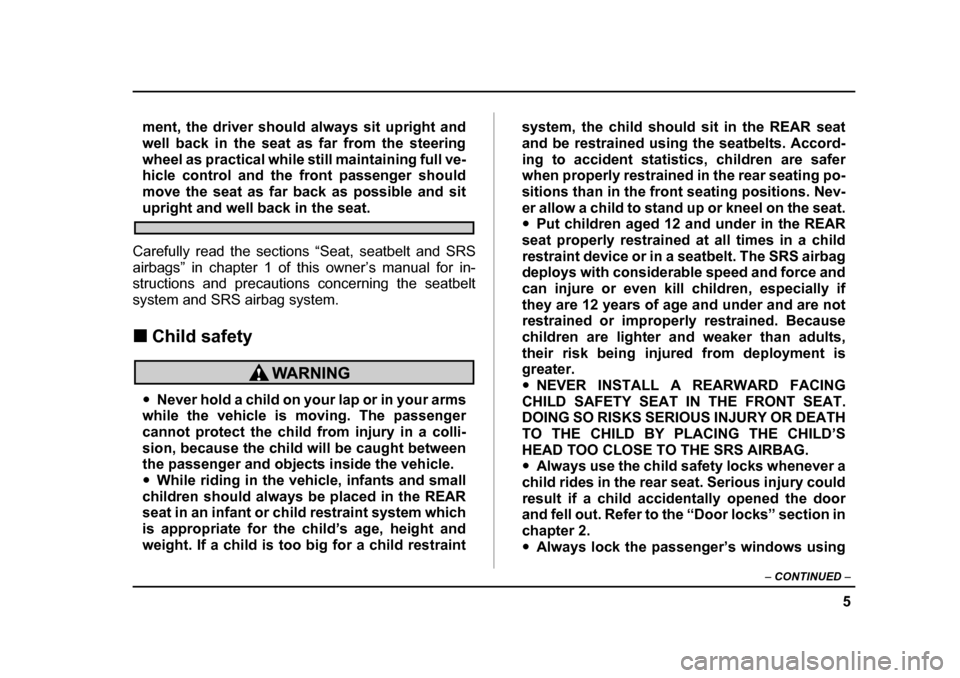
5
–
CONTINUED –
ment, the driver should always sit upright and
well back in the seat as far from the steering
wheel as practical while still maintaining full ve-
hicle control and the front passenger should
move the seat as far back as possible and sit
upright and well back in the seat.
Carefully read the sections “Seat, seatbelt and SRS
airbags” in chapter 1 of this owner’s manual for in-
structions and precautions concerning the seatbelt
system and SRS airbag system. �„ Child safety
�yNever hold a child on your lap or in your arms
while the vehicle is moving. The passenger
cannot protect the child from injury in a colli-
sion, because the child will be caught between
the passenger and objects inside the vehicle. �y While riding in the vehicle, infants and small
children should always be placed in the REAR
seat in an infant or child restraint system which
is appropriate for the child’s age, height and
weight. If a child is too big for a child restraint system, the child should sit in the REAR seat
and be restrained using the seatbelts. Accord-
ing to accident statistics, children are safer
when properly restrained in the rear seating po-
sitions than in the front seating positions. Nev-
er allow a child to stand up or kneel on the seat. �y
Put children aged 12 and under in the REAR
seat properly restrained at all times in a child
restraint device or in a seatbelt. The SRS airbag
deploys with considerable speed and force and
can injure or even kill children, especially if
they are 12 years of age and under and are not
restrained or improperly restrained. Because
children are lighter and weaker than adults,
their risk being injured from deployment is
greater. �y NEVER INSTALL A REARWARD FACING
CHILD SAFETY SEAT IN THE FRONT SEAT.
DOING SO RISKS SERIOUS INJURY OR DEATH
TO THE CHILD BY PLACING THE CHILD’S
HEAD TOO CLOSE TO THE SRS AIRBAG. �y Always use the child safety locks whenever a
child rides in the rear seat. Serious injury could
result if a child accidentally opened the door
and fell out. Refer to the “Door locks” section in
chapter 2.�y Always lock the passenger’s windows using
Page 28 of 469
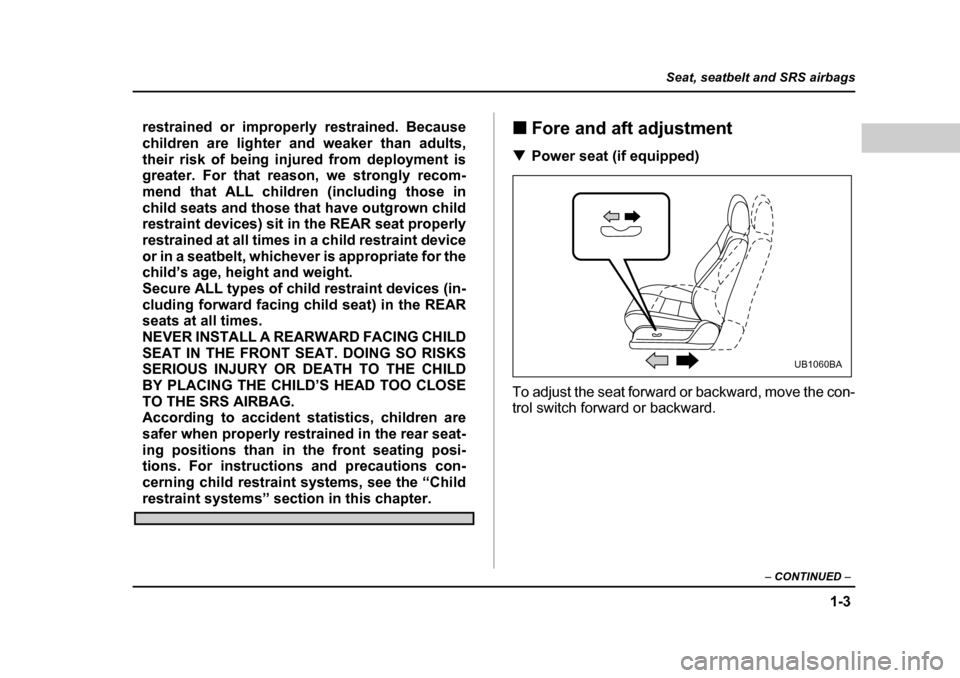
1-3
Seat, seatbelt and SRS airbags
– CONTINUED –
restrained or improperly restrained. Because
children are lighter and weaker than adults,
their risk of being injured from deployment is
greater. For that reason, we strongly recom-
mend that ALL children (including those in
child seats and those that have outgrown child
restraint devices) sit in the REAR seat properly
restrained at all times in a child restraint device
or in a seatbelt, whichever is appropriate for the
child’s age, height and weight.
Secure ALL types of child restraint devices (in-
cluding forward facing child seat) in the REAR
seats at all times.
NEVER INSTALL A REARWARD FACING CHILDSEAT IN THE FRONT SEAT. DOING SO RISKS
SERIOUS INJURY OR DEATH TO THE CHILD
BY PLACING THE CHILD’S HEAD TOO CLOSE
TO THE SRS AIRBAG.
According to accident statistics, children are
safer when properly restrained in the rear seat-
ing positions than in the front seating posi-
tions. For instructions and precautions con-
cerning child restraint systems, see the “Child
restraint systems” section in this chapter. �„
Fore and aft adjustment
�T Power seat (if equipped)
To adjust the seat forward or backward, move the con-
trol switch forward or backward.
UB1060BA
Page 40 of 469
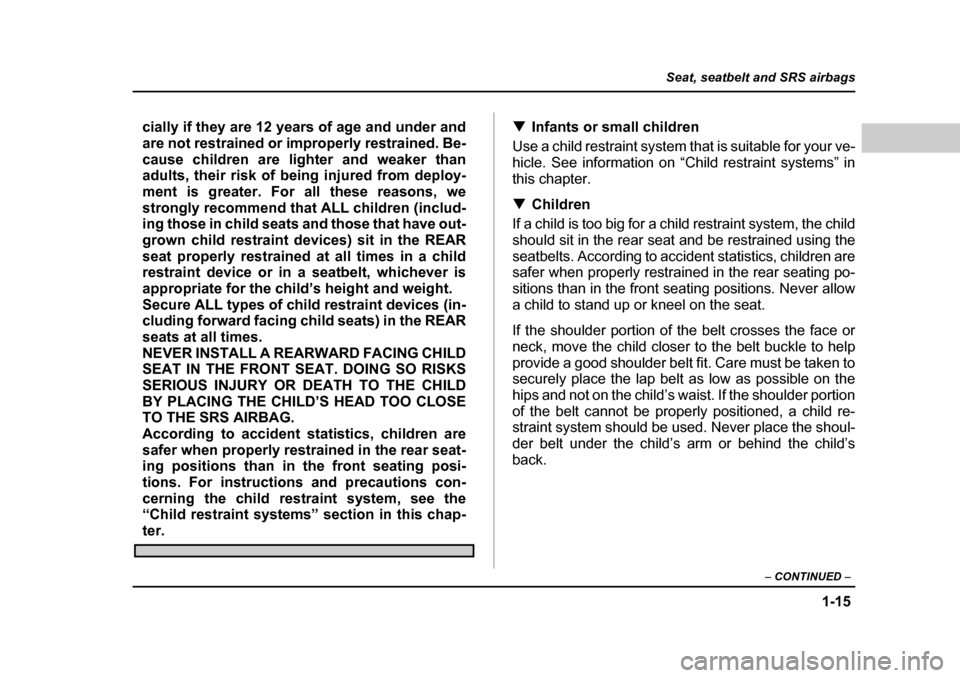
1-15
Seat, seatbelt and SRS airbags
– CONTINUED –
cially if they are 12 years of age and under and
are not restrained or improperly restrained. Be-
cause children are lighter and weaker than
adults, their risk of being injured from deploy-
ment is greater. For all these reasons, we
strongly recommend that ALL children (includ-
ing those in child seats and those that have out-
grown child restraint devices) sit in the REAR
seat properly restrained at all times in a child
restraint device or in a seatbelt, whichever is
appropriate for the child’s height and weight.
Secure ALL types of child restraint devices (in-
cluding forward facing child seats) in the REAR
seats at all times.
NEVER INSTALL A REARWARD FACING CHILD SEAT IN THE FRONT SEAT. DOING SO RISKS
SERIOUS INJURY OR DEATH TO THE CHILD
BY PLACING THE CHILD’S HEAD TOO CLOSE
TO THE SRS AIRBAG.
According to accident statistics, children are
safer when properly restrained in the rear seat-
ing positions than in the front seating posi-
tions. For instructions and precautions con-
cerning the child restraint system, see the
“Child restraint systems” section in this chap-
ter. �T
Infants or small children
Use a child restraint system that is suitable for your ve-
hicle. See information on “Child restraint systems” in
this chapter. �T Children
If a child is too big for a child restraint system, the child
should sit in the rear seat and be restrained using the
seatbelts. According to accident statistics, children are
safer when properly restrained in the rear seating po-
sitions than in the front seating positions. Never allow
a child to stand up or kneel on the seat.
If the shoulder portion of the belt crosses the face or
neck, move the child closer to the belt buckle to help
provide a good shoulder belt fit. Care must be taken to
securely place the lap belt as low as possible on the
hips and not on the child’s waist. If the shoulder portion
of the belt cannot be properly positioned, a child re-
straint system should be used. Never place the shoul-
der belt under the child’s arm or behind the child’sback.
Page 55 of 469
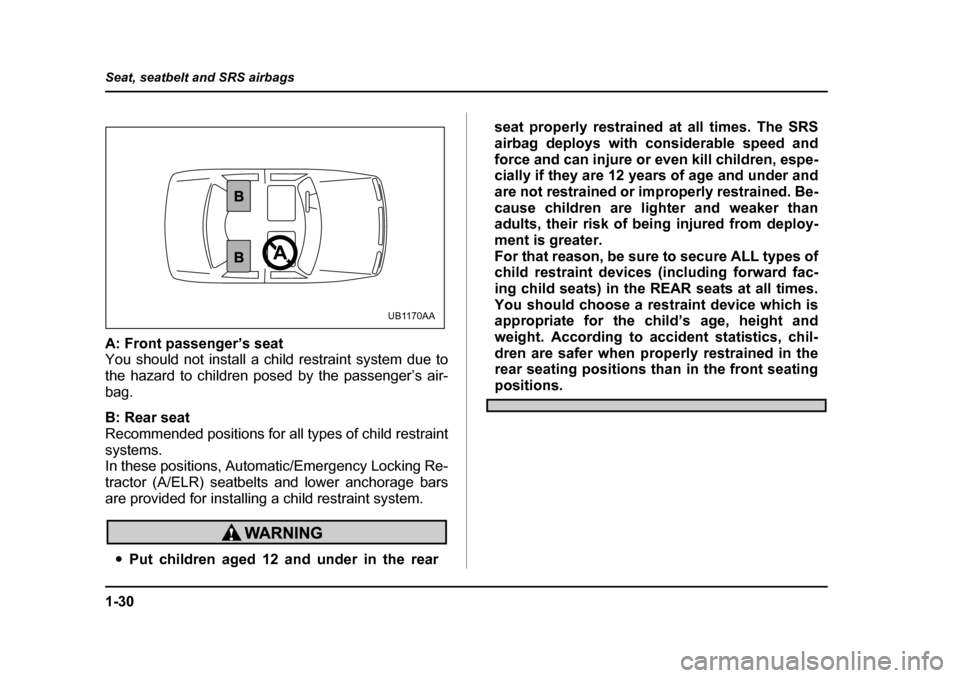
1-30
Seat, seatbelt and SRS airbags
A: Front passenger’s seat
You should not install a child restraint system due to
the hazard to children posed by the passenger’s air-
bag.
B: Rear seat
Recommended positions for all types of child restraint
systems.
In these positions, Automatic/Emergency Locking Re-
tractor (A/ELR) seatbelts and lower anchorage bars
are provided for installing a child restraint system.
�y
Put children aged 12 and under in the rear seat properly restrained at all times. The SRS
airbag deploys with considerable speed and
force and can injure or even kill children, espe-
cially if they are 12 years of age and under and
are not restrained or improperly restrained. Be-
cause children are lighter and weaker than
adults, their risk of being injured from deploy-
ment is greater.
For that reason, be sure to secure ALL types of
child restraint devices (including forward fac-
ing child seats) in the REAR seats at all times.
You should choose a restraint device which is
appropriate for the child’s age, height and
weight. According to accident statistics, chil-
dren are safer when properly restrained in the
rear seating positions than in the front seating
positions.
UB1170AA
Page 56 of 469
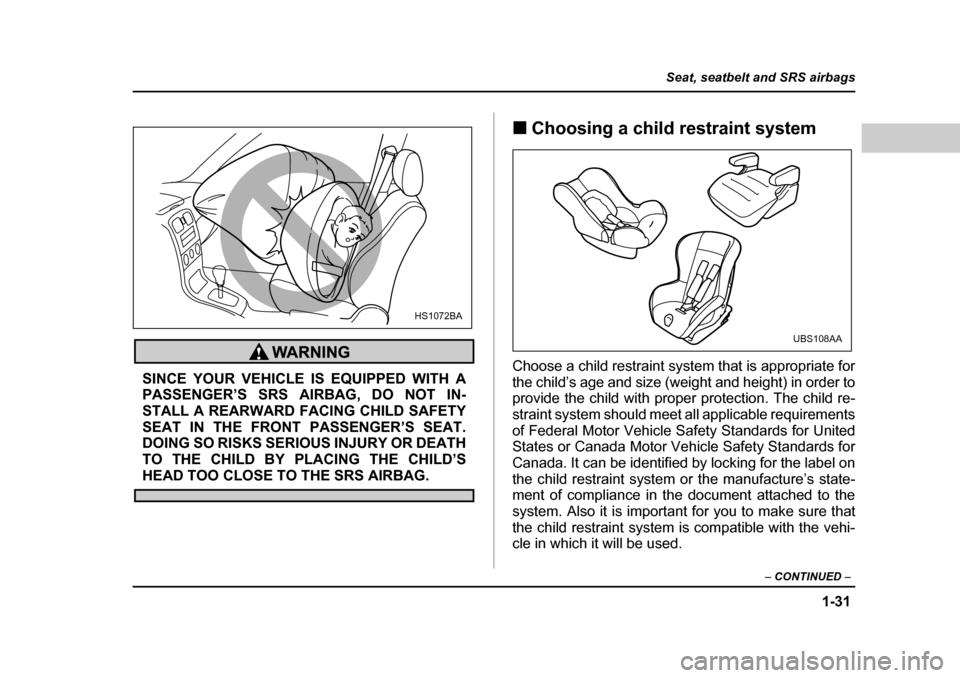
1-31
Seat, seatbelt and SRS airbags
– CONTINUED –
SINCE YOUR VEHICLE IS EQUIPPED WITH A
PASSENGER’S SRS AIRBAG, DO NOT IN-
STALL A REARWARD FACING CHILD SAFETY
SEAT IN THE FRONT PASSENGER’S SEAT.
DOING SO RISKS SERIOUS INJURY OR DEATH
TO THE CHILD BY PLACING THE CHILD’S
HEAD TOO CLOSE TO THE SRS AIRBAG. �„
Choosing a child restraint system
Choose a child restraint system that is appropriate for
the child’s age and size (weight and height) in order to
provide the child with proper protection. The child re-
straint system should meet all applicable requirements
of Federal Motor Vehicle Safety Standards for United
States or Canada Motor Vehicle Safety Standards for
Canada. It can be identified by locking for the label on
the child restraint system or the manufacture’s state-
ment of compliance in the document attached to the
system. Also it is important for you to make sure that
the child restraint system is compatible with the vehi-
cle in which it will be used.
HS1072BA
UBS108AA
Page 74 of 469
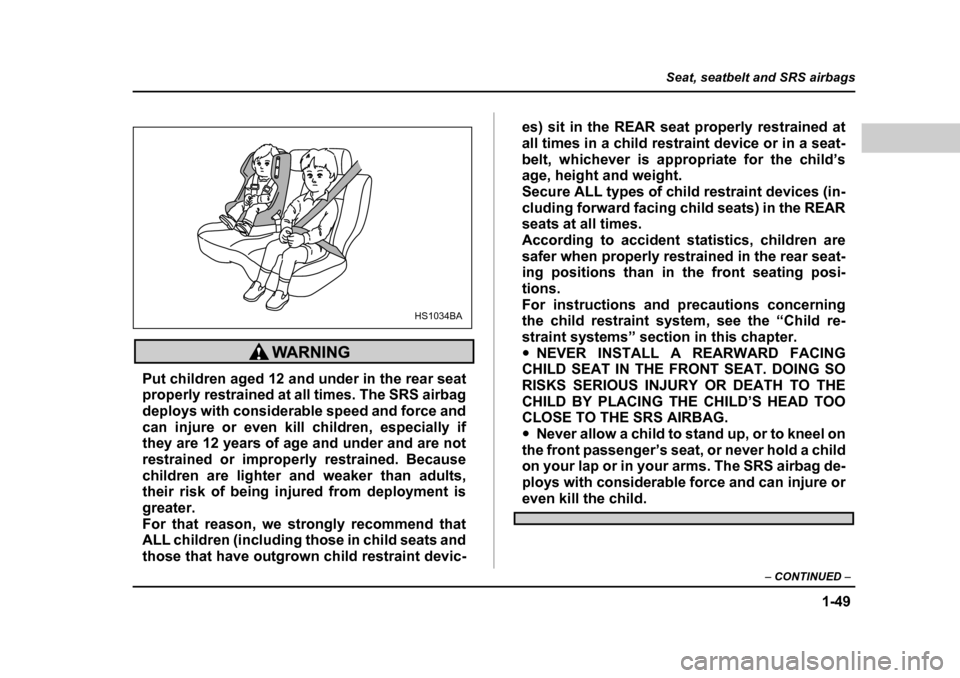
1-49
Seat, seatbelt and SRS airbags
– CONTINUED –
Put children aged 12 and under in the rear seat
properly restrained at all times. The SRS airbag
deploys with considerable speed and force and
can injure or even kill children, especially if
they are 12 years of age and under and are not
restrained or improperly restrained. Because
children are lighter and weaker than adults,
their risk of being injured from deployment is
greater.
For that reason, we strongly recommend that
ALL children (including those in child seats and
those that have outgrown child restraint devic- es) sit in the REAR seat properly restrained at
all times in a child restraint device or in a seat-
belt, whichever is appropriate for the child’s
age, height and weight.
Secure ALL types of child restraint devices (in-
cluding forward facing child seats) in the REAR
seats at all times.
According to accident statistics, children are
safer when properly restrained in the rear seat-
ing positions than in the front seating posi- tions.
For instructions and precautions concerning
the child restraint system, see the “Child re-
straint systems” section in this chapter.�y
NEVER INSTALL A REARWARD FACING
CHILD SEAT IN THE FRONT SEAT. DOING SO
RISKS SERIOUS INJURY OR DEATH TO THE
CHILD BY PLACING THE CHILD’S HEAD TOO
CLOSE TO THE SRS AIRBAG. �y Never allow a child to stand up, or to kneel on
the front passenger’s seat, or never hold a child
on your lap or in your arms. The SRS airbag de-
ploys with considerable force and can injure or
even kill the child.
HS1034BA
Page 219 of 469

6-16
Interior and exterior equipments
Cargo bed
�y
Never fill gasoline containers on the cargo
bed. Static electricity may ignite gasoline vapor
when filling portable containers. Approved
containers must be removed from the vehicle
and placed on the ground when filling.
Do not fill any portable container on a vehicle.�y Never allow anyone to ride in the cargo bed.
It is not designed for passengers. They should
ride in the seats with the seatbelts securely fas-
tened. Otherwise they are much more likely to suffer serious injury or death in a sudden brak-
ing or in a collision.
�y
Do not exceed the cargo load rating of your
vehicle. Refer to the “Loading your vehicle”
section in Chapter 8.�y Be sure cargo is secured properly. Unse-
cured cargo in the cargo bed can be thrown
around during sudden braking, in a sharp turn
or during rapid acceleration, which could cre-
ate a dangerous road hazard. �y To avoid creating a dangerous road hazard or
causing personal injury, cargo must not stick
out beyond the tailgate. �y Never drive the vehicle with the tailgate open
unless the optional SUBARU Bed Extender is
used.
Cargo should be placed in the cargo bed. Make sure
all items are secured in place.
Be careful to keep the vehicle balanced. Locating the
weight as low and far forward as possible helps main-
tain balance.
There are two water drain holes at both sides of the
UB1149BA
Page 227 of 469
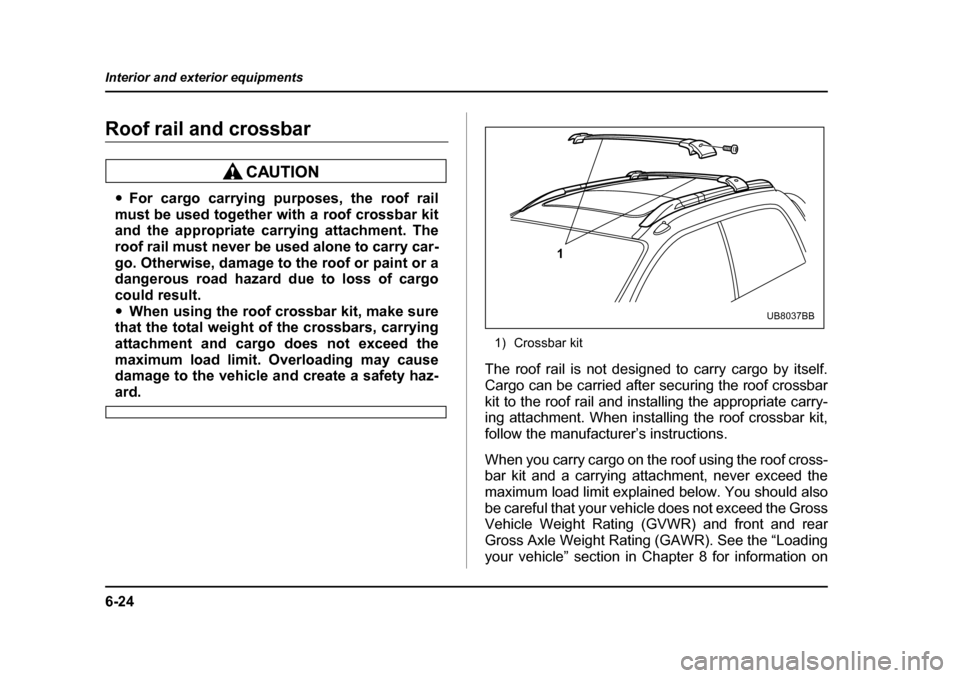
6-24
Interior and exterior equipments
Roof rail and crossbar
�y
For cargo carrying purposes, the roof rail
must be used together with a roof crossbar kit
and the appropriate carrying attachment. The
roof rail must never be used alone to carry car-
go. Otherwise, damage to the roof or paint or a
dangerous road hazard due to loss of cargo
could result. �y When using the roof crossbar kit, make sure
that the total weight of the crossbars, carrying
attachment and cargo does not exceed the
maximum load limit. Overloading may cause
damage to the vehicle and create a safety haz-
ard. 1) Crossbar kit
The roof rail is not designed to carry cargo by itself.
Cargo can be carried after securing the roof crossbar
kit to the roof rail and installing the appropriate carry-
ing attachment. When installing the roof crossbar kit,
follow the manufacturer’s instructions.
When you carry cargo on the roof using the roof cross-
bar kit and a carrying attachment, never exceed the
maximum load limit explained below. You should also
be careful that your vehicle does not exceed the Gross
Vehicle Weight Rating (GVWR) and front and rear
Gross Axle Weight Rating (GAWR). See the “Loading
your vehicle” section in Chapter 8 for information on
1
UB8037BB